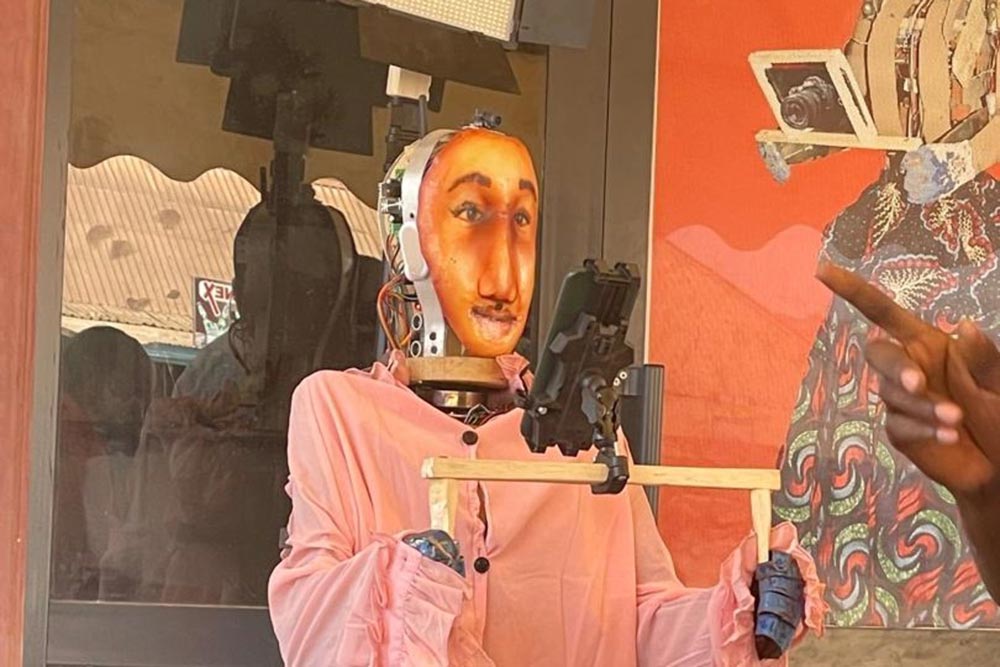
East Africa is fast becoming a hub for technological innovation. From Kenya’s participation in world space projects and now, Tanzania’s robot photographer. This innovative piece of technology is not just capturing attention for its futuristic charm, but also reshaping how we view the role of photography in social events… Imagine attending a wedding, party, or corporate function, and instead of a human photographer moving through the crowd to capture candid moments, a sleek, intelligent robot glides through, identifying key moments, adjusting angles and snapping high-quality photos. This isn’t science fiction; it’s on the horizon of reality in Tanzania today, thanks to the advent of the robot photographer.
Courtesy of 12 young Tanzanians, the robot was developed to address challenges faced by videographers such as long-standing hours.
According to The Citizen, the robot was developed with experts in electronics, metalwork, wood and aluminium with the capability to operate both day and night thanks to built-in lighting. Not to mention guidance from Prof. Baraka Maiseli, head of the Electronics and Communication Engineering department at the University of Dar es Salaam’s College of Information and Communication Technologies.
One of the innovators, Brighton Katabazi director of KBTIT, a video recording studio in Dodoma shared that the idea came up last year, motivated by challenges experienced by his studio staff who often stood for long hours during video coverage.
Read Also: Why Customer Experience Matters in Business Today
Read Also: AI in Uganda’s Higher Education – Opportunities, Challenges, and Policy Needs

“Sometimes, our workers have to stand in the sun while the person being recorded is in the shade. If the camera is left unattended and the subject moves, the operator has to adjust it manually,” Katabazi explained. “These challenges inspired us to design a robot that can hold a camera and capture high-quality images without the need for a human to move around.”
While the robot currently operates via remote control, the team plans to incorporate artificial intelligence for autonomous functionality, capable of navigating crowded spaces using built-in sensors and cameras to avoid obstacles while tracking movement.
As it stands, only 45% of the project has been completed with an investment of 3.5 million Tanzanian shillings collected. The team expects the total project cost to reach 15 million shillings upon completion.
The Tanzanian government has been encouraging local innovation in AI and robotics, increasing funding to boost such initiatives. The Dodoma District Commissioner, Jabir Shekimweri, who officiated the robot’s preliminary launch, applauded the team’s efforts. However, he advised them to focus on refining the robot’s appearance to improve its marketability, emphasizing that aesthetics is just as important as functionality for mass appeal.
Read Also: 8 Clear Signs You Are Texting a Chatbot, Not a Human
Read Also: Meta Movie Gen: How Realistic Can AI-Generated Video Get?
“Functionality is important, but appearance matters too. Even if the product works perfectly, if it doesn’t look appealing it can deter potential buyers,” Shekimweri advised.
This came after the government had increased funding towards AI and robotics in the national budget highlighting the supportive environment for such local innovations.
The arrival of Tanzania’s robot photographer signals a new chapter in the nation’s technological development. As AI and robotics continue to improve, we can expect more innovations like this across various industries, pushing Tanzania to the forefront of tech in Africa.
Read Also: Protecting Kids Online: The Dangers of Sharenting Photos
Read Also: Spotting AI-Generated Content from Human Art
For event planners, media houses and photographers, this is an exciting time—one filled with new opportunities and challenges. The robot photographer offers efficiency, novelty, and a glimpse into the future, but it also raises questions about the balance between automation and human creativity.
While the robot photographer represents an exciting leap forward, it’s important to note that it isn’t necessarily a replacement for human photographers. Rather, it’s a complementary tool. Human photographers bring creativity, intuition and artistic flair to their work—qualities that a robot, for now, cannot replicate. Where a human photographer sees a perfect candid moment or anticipates an emotional reaction, the robot might still fall short.
Instead, robots could take over routine tasks or cover areas that might be missed by human photographers. In a scenario where both work together: the robot handles general event coverage, while a human photographer focuses on artistic, posed shots, or moments that require a creative touch. This hybrid approach could redefine event photography.